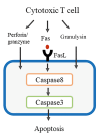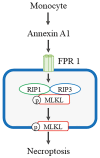Stevens-Johnson syndrome and toxic epidermal necrolysis: Updates in pathophysiology and management
- PMID: 39238098
- PMCID: PMC11441865
- DOI: 10.1097/CM9.0000000000003250
Stevens-Johnson syndrome and toxic epidermal necrolysis: Updates in pathophysiology and management
Abstract
Stevens-Johnson syndrome (SJS) and toxic epidermal necrolysis (TEN) are life-threatening conditions characterized by extensive detachment of the epidermis and mucous membranes. These severe disorders carry a high mortality rate, and their pathogenesis remains largely unclear. Furthermore, optimal therapeutic strategies for SJS/TEN remain a subject of ongoing debate. Early diagnosis of SJS/TEN is challenging, and reliable biomarkers for diagnosis or severity prediction have not been firmly established. Certain drugs, such as carbamazepine and allopurinol, have shown a strong association with specific human leukocyte antigen (HLA) types. Recently, the potential benefits of HLA screening prior to administering these drugs to reduce the incidence of SJS/TEN have been explored. Epidermal cell death in SJS/TEN lesions is caused by extensive apoptosis, primarily through the Fas-Fas ligand (FasL) and perforin/granzyme pathways. Our findings suggest that necroptosis, a form of programmed necrosis, also contributes to epidermal cell death. Annexin A1, released from monocytes, interacts with the formyl peptide receptor 1 to induce necroptosis. Several biomarkers, such as CC chemokine ligand (CCL)-27, interleukin-15, galectin-7, receptor-interacting protein kinases 3 (RIP3), and lipocalin-2, have been identified for diagnostic and prognostic purposes in SJS/TEN. Supportive care is recommended for treating SJS/TEN, but the efficacy of various therapeutic options-including systemic corticosteroids, intravenous immunoglobulin, cyclosporine, and tumor necrosis factor-α antagonists-remains controversial. Recent studies have investigated the potential benefits of tumor necrosis factor-α antagonists. In this review, we discuss recent advances in the understanding and management of SJS/TEN.
Copyright © 2024 The Chinese Medical Association, produced by Wolters Kluwer, Inc. under the CC-BY-NC-ND license.
Conflict of interest statement
None.
Figures





Similar articles
-
Recent advances in managing and understanding Stevens-Johnson syndrome and toxic epidermal necrolysis.F1000Res. 2020 Jun 16;9:F1000 Faculty Rev-612. doi: 10.12688/f1000research.24748.1. eCollection 2020. F1000Res. 2020. PMID: 32595945 Free PMC article. Review.
-
Genetic markers and danger signals in stevens-johnson syndrome and toxic epidermal necrolysis.Allergol Int. 2010 Dec;59(4):325-32. doi: 10.2332/allergolint.10-RAI-0261. Epub 2010 Oct 25. Allergol Int. 2010. PMID: 20962567 Review.
-
Stevens-johnson Syndrome and Toxic Epidermal Necrolysis: An Overview of Diagnosis, Therapy Options and Prognosis of Patients.Recent Adv Inflamm Allergy Drug Discov. 2023;17(2):110-120. doi: 10.2174/2772270817666230821102441. Recent Adv Inflamm Allergy Drug Discov. 2023. PMID: 37605396
-
Stevens-Johnson Syndrome and Toxic Epidermal Necrolysis in the Era of Systems Medicine.Methods Mol Biol. 2022;2486:37-54. doi: 10.1007/978-1-0716-2265-0_3. Methods Mol Biol. 2022. PMID: 35437717
-
Recent progress in Stevens-Johnson syndrome/toxic epidermal necrolysis: diagnostic criteria, pathogenesis and treatment.Br J Dermatol. 2024 Dec 23;192(1):9-18. doi: 10.1093/bjd/ljae321. Br J Dermatol. 2024. PMID: 39141587 Review.
Cited by
-
Lamotrigine Therapy: Relation Between Treatment of Bipolar Affective Disorder and Incidence of Stevens-Johnson Syndrome-A Narrative Review of the Existing Literature.J Clin Med. 2025 Jun 10;14(12):4103. doi: 10.3390/jcm14124103. J Clin Med. 2025. PMID: 40565849 Free PMC article. Review.
-
Clinical characteristics of Stevens-Johnson syndrome/toxic epidermal necrolysis-like reactions induced by immune checkpoint inhibitors.Oncologist. 2025 Jun 4;30(6):oyaf143. doi: 10.1093/oncolo/oyaf143. Oncologist. 2025. PMID: 40491130 Free PMC article.
-
Adalimumab combination with corticosteroid therapy for Stevens-Johnson syndrome/toxic epidermal necrolysis.Arch Dermatol Res. 2025 Apr 10;317(1):694. doi: 10.1007/s00403-025-04214-x. Arch Dermatol Res. 2025. PMID: 40208337 Free PMC article.
-
A review of the immunogenetics of Stevens-Johnson syndrome and toxic epidermal necrolysis.Glob Med Genet. 2025 May 7;12(3):100054. doi: 10.1016/j.gmg.2025.100054. eCollection 2025 Sep. Glob Med Genet. 2025. PMID: 40469883 Free PMC article. Review.
-
Understanding the Gap Between Acute Complications and Long-Term Sequelae in Patients with Stevens-Johnson Syndrome and Toxic Epidermal Necrolysis in Bandung, West Java, Indonesia: Experience from Two Institutions.Clin Cosmet Investig Dermatol. 2025 Apr 21;18:979-988. doi: 10.2147/CCID.S514590. eCollection 2025. Clin Cosmet Investig Dermatol. 2025. PMID: 40292010 Free PMC article.
References
-
- Bastuji-Garin S, Rzany B, Stern RS, Shear NH, Naldi L, Roujeau JC. Clinical classification of cases of toxic epidermal necrolysis, Stevens-Johnson syndrome, and erythema multiforme. Arch Dermatol 1993;129:92–96. doi: 10.1001/archderm.1993.01680220104023. - PubMed
-
- Sunaga Y Kurosawa M Ochiai H Watanabe H Sueki H Azukizawa H, et al. . The nationwide epidemiological survey of Stevens-Johnson syndrome and toxic epidermal necrolysis in Japan, 2016-2018. J Dermatol Sci 2020;100:175–182. doi: 10.1016/j.jdermsci.2020.09.009. - PubMed
-
- Revuz J Penso D Roujeau JC Guillaume JC Payne CR Wechsler J, et al. . Toxic epidermal necrolysis. Clinical findings and prognosis factors in 87 patients. Arch Dermatol 1987;123:1160–1165. doi: 10.1001/archderm.123.9.1160. - PubMed
-
- Mockenhaupt M Viboud C Dunant A Naldi L Halevy S Bouwes Bavinck JN, et al. . Stevens-Johnson syndrome and toxic epidermal necrolysis: Assessment of medication risks with emphasis on recently marketed drugs. The EuroSCAR-study. J Invest Dermatol 2008;128:35–44. doi: 10.1038/sj.jid.5701033. - PubMed
Publication types
MeSH terms
Substances
LinkOut - more resources
Full Text Sources
Research Materials
Miscellaneous

